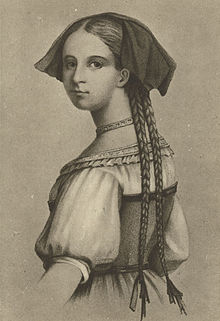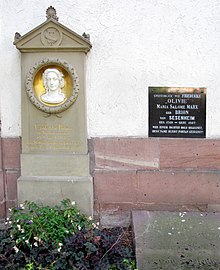Friederike Brion
Friederike Elisabeth Brion (* probably April 19, 1752 in Niederrödern in Alsace ; † April 3, 1813 in Meißenheim near Lahr ) was an Alsatian pastor's daughter and had a brief but intense love affair with young Goethe .
Life
Friederike's date of birth is not certain because the church records were destroyed in the turmoil of the French Revolution . She was the third of five surviving children of Johann Jakob and Maria Magdalena Brion geb. Schöll. At Martini 1760, her father took a job as a village pastor in Sessenheim , written by Goethe as “Sesenheim”. The pretty, cheerful but somewhat sickly girl grew up there.
Among the young people who occasionally visited the hospitable rectory was the Strasbourg law student Johann Wolfgang Goethe from Frankfurt . He had gone to Strasbourg to study in order to acquire a doctorate in law there - in continuation of his studies in Leipzig. In autumn 1770 he and his Alsatian friend Friedrich Leopold Weyland came to the small village of Sessenheim, 40 kilometers northeast of Strasbourg, for the first time while roaming around Strasbourg . This excursion would result in one of the most famous love episodes in literary history.
Goethe later reported on his first encounter with Friederike: “At that moment she really stepped in the door; and then a very dearest star rose in this rural sky. [...] Slender and light, as if she had nothing to wear, she strode, and the neck almost seemed too delicate for the huge blond braids of the cute little head. With cheerful blue eyes she looked around very clearly, and the well-behaved snub nose searched the air as freely as if there could be no worry in the world; the straw hat hung on the arm, and so I had the pleasure of seeing and recognizing her at first glance in all her grace and loveliness. "

In the next few months, Goethe made many “folles chevauchées” (great rides) to Sessenheim, which were followed by extended stays at the Brion house. Unobserved, he and Friederike roamed the area, took boat trips in the then even more extensive Rhine floodplains and visited friends of Friederike. For the next year, the small town became the “center of the earth” for Goethe.
Through this limitless happiness "the desire to write poetry suddenly emerged" which Goethe "had not felt for a long time". In the spring of 1771 a series of poems and songs was written, which were sometimes sent to the beloved with "painted ribbons"; these “ Sesenheimer Lieder ” are a major part of the “ Sturm und Drang ” and established Goethe's reputation as a poet . Among them are, for example, the “ Mailied ”, “ Welcome and Farewell ” and “Das Heidenröslein ”. In 1771 he also translated the "The Chants of Selma" from James Macpherson's " Ossian " for her.
However, the love affair did not last long. Already in the early summer of 1771, Goethe, who compared his restless soul with the "weather cock over there on the church tower", thought of ending the relationship. On August 7th, 1771 he saw Friederike for the last time before returning to Frankfurt: "When I took her hand from the horse, tears stood in her eyes and I felt very nauseous." Left the "wonderful Alsace" he already a week later. It was only from Frankfurt that he wrote a letter to Friederike that finally resolved the relationship. Friederike's answer “tore my heart ... I always felt that I missed it and, worst of all, I couldn't forgive myself for my own misfortune. [...] Here I was guilty for the first time; - but the farewell was final. ”So he felt himself that he had not behaved like a“ gentilhomme ”when it came to the solution. After that, however, Goethe returned at least one more time - on a trip to Switzerland in 1779 - to the vicarage of Sessenheim. Some uncertain sources mention another visit in 1782 for the wedding of Friederike's older sister Maria Salomea with the Strasbourg-born Magister Gottfried Marx, who had just become pastor in Diersburg .
In the summer of 1772, the poet Jakob Michael Reinhold Lenz , an admirer of Goethe who kept in touch with him in Strasbourg, recruited Friederike, who was still suffering from great lovesickness: “Where are you now, my unforgettable girl, | Where are you singing now | Where is the hallway laughing? Where does the town triumph | Who owns you? "
Friederike Brion, however, remained unmarried until the end of her life and lived in her parents' house until her father's death in 1787; the mother had died a year earlier. Then Friederike moved with her younger sister Sofie to live with her brother Christian in the parish of Rothau in the Steintal . The two stayed there even after his transfer. For their livelihood, the sisters sold weaving, earthenware and pottery goods and handicrafts and for some time maintained a pension for girls from Sessenheim and the surrounding area who were supposed to learn French at a school built for this purpose in Rothau.
In 1801 Friederike moved to the rectory in Diersburg to support her ailing sister and stayed there with a few interruptions. She followed the family to Meißenheim in Baden in 1805 . In 1807 the sister died. Friederike stayed with her brother-in-law. She was not in the best of health either. At the beginning of 1813 she had to ask her sister Sofie to take care of her. She died on April 3, 1813 and was buried on April 5 in the cemetery of the Meißenheim church . The tombstone that can still be seen there today, made by the sculptor Wilhelm Hornberger , was not erected until 1866 on the completely neglected grave site. On August 19 of that year, Friedrich Gessler gave the dedication speech there. The inscription reads, based on a verse by Ludwig Eckardt : "A stral of the poet's son̄e fell on her, so rich that it gave her immortality!"
Survival in art
Friederike Brion did not experience the enthusiastic interest that set in after the love story was published in the second and third parts of Goethe's Poetry and Truth (1812/14). Goethe, on the other hand, was different: in his essay “Repeated Reflections” (1823) he dealt with the leaked report of a trip that Bonn professor August Ferdinand Naeke had undertaken in search of traces of the Sessenheim love story the year before. On a similar trip in 1835, Heinrich Kruse , a student of Naekes, found the complete collection of Goethe's and Lenzen's “Sesenheimer Lieder” with Friederike's last surviving sister.
In the further course of the 19th century a real Friederiken cult began, which produced various artistic and scientific works in which the Sesenheim idyll was transfigured. The transfiguration was seriously disturbed by rumors that Friederike did not remain the innocent pastor's daughter when Goethe described her, but had given birth to one or more illegitimate children. There was even speculation about a child from the relationship with Goethe. The Strasbourg Goethe researcher Johann Froitzheim met with violent opposition when he tried to scientifically support these rumors in a series of publications using historical sources.
Franz Lehár's 1928 operetta Friederike is based on the love affair between her and Goethe.
literature
- August Ferdinand Naeke: Pilgrimage to Sesenheim. Edited by Karl August Varnhagen von Ense . Duncker & Humblot, Berlin 1840.
- August Stöber: The poet Lenz and Friedericke von Sesenheim. Basel 1842 ( books.google.com ).
- Heinrich Kruse: Pilgrimage to Sesenheim. In: Deutsche Rundschau . 17, 1878, pp. 218-226 ( digitized in Google Book Search USA ).
- Albert Bielschowsky : Friederike Brion. A contribution to Goethe literature. Verlag der Schletter'schen Buchhandlung E. Franck, Breslau 1880 ( archive.org ).
- Wolfdietrich Rasch: Brion, Friederike Elisabeth. In: New German Biography (NDB). Volume 2, Duncker & Humblot, Berlin 1955, ISBN 3-428-00183-4 , p. 617 f. ( Digitized version ).
- Friedrich Ernst Peters : Meissenheim. A travel memory. In: ders .: Gebild und Leben. Bernaerts, Schleswig 1955, pp. 214-220 ( UB Potsdam ).
- Gero von Wilpert : Brion, Friederike. In: ders .: Goethe-Lexikon (= Kröner's pocket edition . Volume 407). Kröner, Stuttgart 1998, ISBN 3-520-40701-9 , p. 143 f.
- August Ferdinand Naeke, Heinrich Kruse: Pilgrimage to Sessenheim. The first research into the love idyll of Goethe and Friederike. Edited and introduced by Klaus H. Fischer. Fischer, Schutterwald / Baden 2008, ISBN 978-3-928640-79-4 .
- Helmut Koopmann : Welcome and farewell. Goethe and Friederike Brion. Beck, Munich 2014, ISBN 978-3-406-65998-0 .
- Theo Stemmler: Goethe and Friederike. Inselbücherei No. 1471. Frankfurt / M., 2019.
- Literature by and about Friederike Brion in the catalog of the German National Library
- Friederike Brion. In: FemBio. Women's biography research (with references and citations).
- On Friederike Brion's 200th birthday (PDF file; 15 kB)
Individual evidence
- ↑ Helmut Birkhan : Nachantike Keltenrezeption. P. 362 f.
| personal data | |
|---|---|
| SURNAME | Brion, Friederike |
| ALTERNATIVE NAMES | Brion, Friederike Elisabeth (full name); Brion, Frédérique |
| BRIEF DESCRIPTION | Alsatian pastor's daughter, first great love of Johann Wolfgang Goethe |
| DATE OF BIRTH | uncertain: April 19, 1752 |
| PLACE OF BIRTH | Niederrödern , France |
| DATE OF DEATH | April 3, 1813 |
| Place of death | Meißenheim near Lahr |

